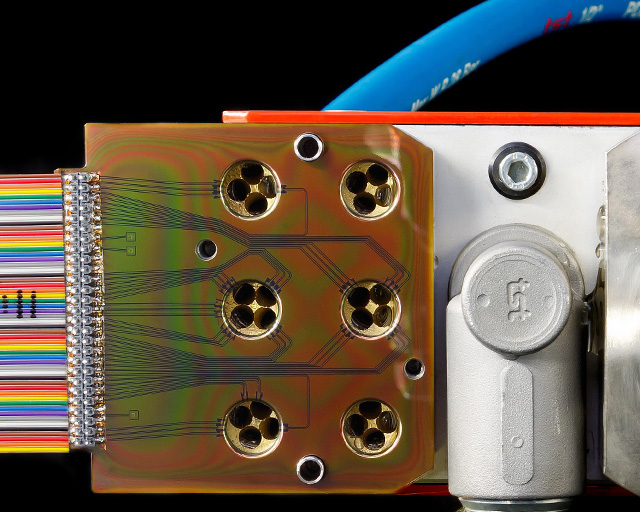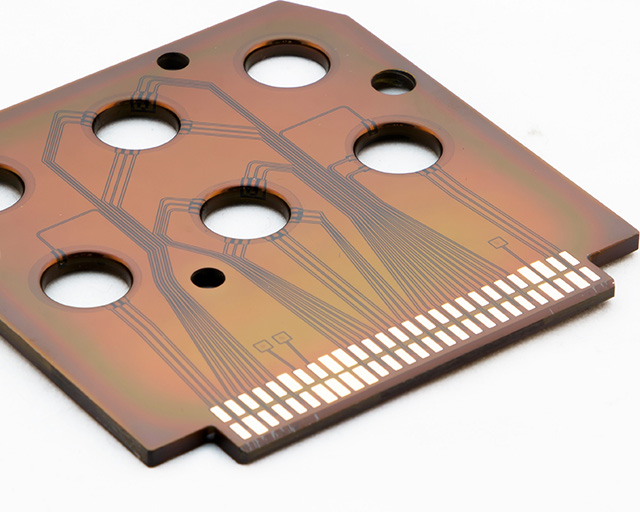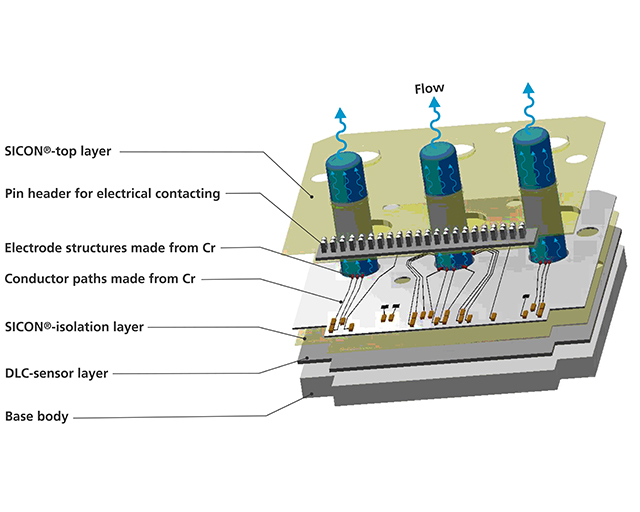
Thin-film sensor technology for the monitoring of temperature control in plastic injection molding

The resource-efficient production of plastic components by means of injection molding is dependent on a precise temperature and flow control of the injection molds. To improve the design and monitoring of mold temperature control, the real temperatures, pressures and flow rates during the injection molding process must be recorded. In order to determine these values, a multi-coupling insert with a multi-sensory and media-resistant thin-film system is being developed at the Fraunhofer IST which, in direct contact with the passing water, should enable the measurement of the variables temperature, pressure and flow rate.




Water and chemical resistance of the sensory layer system
The aim of the ”TivSee” project is to integrate the sensor insert, in direct contact with the passing water as well as various industrial cleaning agents and corrosion inhibitors, into the heating and cooling circuit of temperature control technology. It must therefore be ensured that the sensory thin-film system is resilient and highly resistant to chemical attack, water and temperature. For this purpose, a test rig was developed to investigate the suitability and behavior of the sensor structures and the protective top layer in endurance tests.
Sensory multi-coupling element
As a solution, a special sensor insert was designed for integration within a 6-circuit multi-coupling. The multi-sensory layer system was deposited with high adhesion onto this exchangeable insert into the inner areas of the bore, and conductive tracks were structured across the rounded area. This sensory and media-resistant thin-film system developed at the Fraunhofer IST is based on DLC (diamond-like carbon) coatings produced by means of PECVD (plasma-enhanced chemical vapor deposition) technologies. The integration of chrome-based sensor structures enables the spatially resolved measurement of pressure and temperature. These sensor structures are fabricated using a combination of photolithography and wet-chemical etching processes.
Digitization and monitoring of production processes
This proof of the durability of the sensory thin-film system opens up further fields of application in the realization of highly resilient sensor systems for tribologically demanding systems. In addition, based on the temperature measurements carried out, important findings on measurement principles for flow measurement in thin-film technology were obtained which will be further investigated in the future. Multifunctional thin film sensors also offer far-reaching possibilities in the field of in-situ monitoring in cyber-physical production systems.
Outlook
The results of the project will be used to further develop the measurement principles for flow measurement established here. In addition, the solution developed for temperature and pressure measurement will be examined in further test phases with pilot customers. In the long term, this will result in a measuring system for the combined acquisition of temperature, pressure and flow data.
The project
The results described were achieved within the cooperation project ”Temperature-control coupling with integrated networked sensor technology” (TivSee) on which the Fraunhofer IST worked in collaboration with the companies Nonnenmann GmbH and eck*cellent IT GmbH. The project was funded by the Zentrales Innovationsprogramm Mittelstand, ZIM (central innovation program for small and medium-sized enterprises, SMEs) of the German Federal Ministry for Economic Affairs and Climate Action (BMWK) based on a resolution of the German Bundestag and the German Federation of Industrial Research Associations, AiF.
This article is part of the Annual Report 2021.